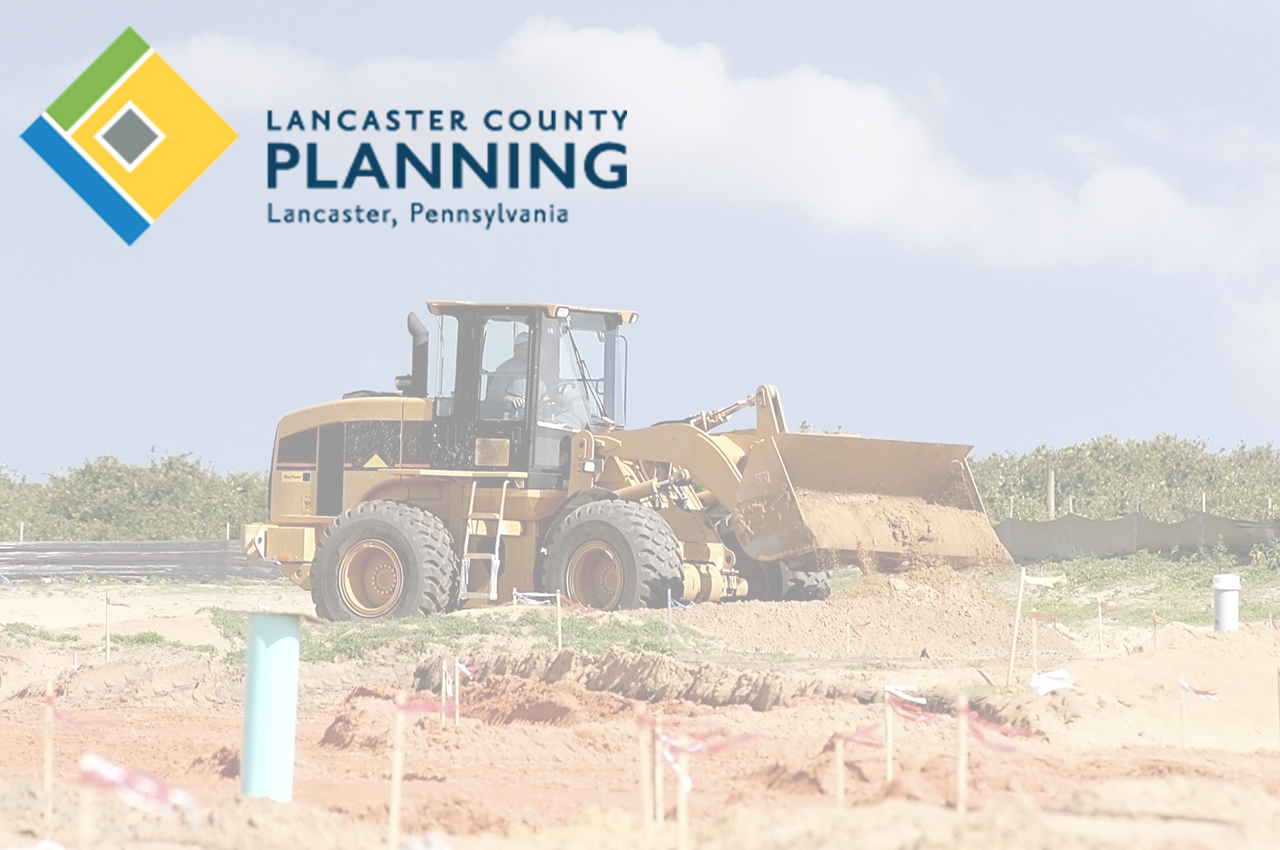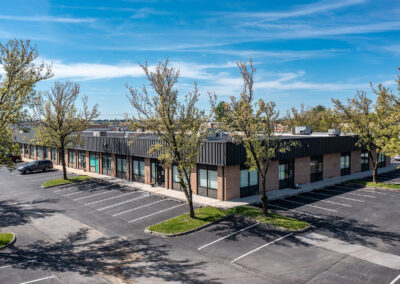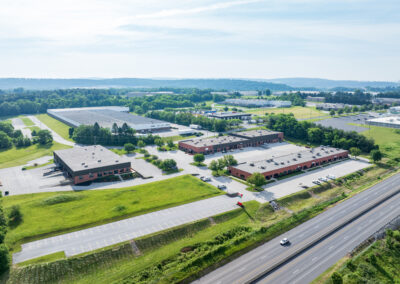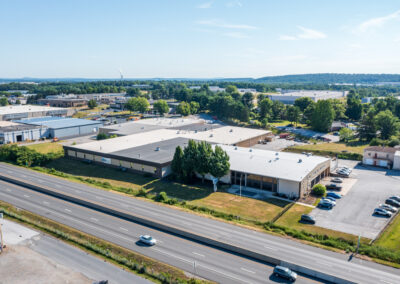Scott Standish and Alex Rohrbaugh from LCPD Give ROCK an Update on Redevelopment in Lancaster
by Katie Spurrier | 7 min. read
One man’s trash is another man’s treasure, or at least that’s the case for some developers. Redevelopment is the process of renovating a previously developed area or property and can take many forms, including the demolition of an existing building or repurposing a property so it aligns with current market trends. Redevelopment projects have the potential to revitalize an area, create new jobs, increase property values, and attract new businesses.1 Redevelopment projects are led by local governments or private developers and often include a mix of public and private funding.
In Lancaster County, several organizations are involved with redevelopment including the Lancaster County Planning Department (LCPD). LCPD is responsible for advising our municipal and other planning partners on comprehensive planning, land use regulation, and community development in Lancaster including consulting with developers about project revisions and working to improve quality of life for residents. ROCK interviewed Scott Standish, Executive Director at LCPD and Alex Rohrbaugh, AICP, Senior Planner at LCPD for their take on redevelopment in Lancaster City.
Q: At ROCK, we’ve noticed several new redevelopment projects in Lancaster. Most are multifamily or mixed-use with first floor commercial tenants and residential units above. Have you noticed the same trend, and how do you feel redevelopment benefits the city?
A: We’re seeing a lot of redevelopment activity happening in the city right now which is extremely exciting. LCPD’s mission includes five big ideas: thinking beyond boundaries; creating great places; connecting people, place, and opportunity; taking care of what we have; and, growing responsibly.2 This market trend will help us grow responsibly. We need more focus on redevelopment of our existing areas where we already have infrastructure including sewer, water, and other services that go along with accommodating a growing population. In Lancaster County, we’ve established urban growth boundaries or designated growth areas because we know Lancaster County will grow by about 60,000 to 100,000 people from now until 2040. We must provide for that growth residentially but also for jobs, manufacturing, institutional uses, and community uses like parks and open spaces. We need to ensure we have enough land within those boundaries to accommodate that growth, or we’ll have to push those boundaries out significantly which would encroach on our farmland, our rural landscape, and our natural resource areas. So how will we do it?
Right now, we’ve been successful at directing a lot of our growth to our urban growth areas. Those areas are either centered on the city or one of the boroughs which are the areas expected to have infrastructure within the timeframe of the next 20 years. About 85% of the units in the last 15-20 years have been developed inside those boundaries. That was our goal and our plan. Where we’re failing is the pattern of that growth because we’re still seeing a lot of low-density development like single family homes on large lots and large commercial buildings on several acres with on-site parking. Our concern is if we don’t start developing more compactly by increasing the number of mixed-use developments and building up instead of out, we will have to expand those boundaries because we can’t stop growth. This is why we’re seeing this uptick in redevelopment which we believe is a move in the right direction.
"Our concern is if we don’t start developing more compactly by increasing the number of mixed-use developments and building up instead of out, we will have to expand those boundaries because we can’t stop growth."
The Economic Development Company of Lancaster County (EDC), which is an agency that normally deals with industrial development and business retention, expansion, and attraction, did a high-level housing analysis for Lancaster County and found the county’s residential vacancy rate is very low compared to our peers of a similar size. They concluded Lancaster is 7,000 to 12,000 units short of what we need to meet housing demand. The multifamily and mixed-use housing choices we’re seeing fulfill this growing need for high-density housing. Another benefit of redevelopment is there is often less resistance from the community because the site has already been developed, and people are accustomed to having something there. The community would rather see a building re-purposed or re-imagined than fall into disrepair from neglect.
Q: At ROCK, we release quarterly market reports for Lancaster County and reported on very low industrial vacancy. It seems users are staying in their current industrial buildings, and there is little new industrial construction planned in Lancaster County. Is this consistent with what you’re seeing?
A: We worked with the EDC a few years ago and did an analysis of all our buildable land within the urban growth areas to determine what sites could be suitable for industrial development, knowing there is a shortage of industrial land. It was eye opening for us and for the EDC to see what sites are actually suitable for industrial development based on a number of factors like being close to an interchange, having over 10 acres, water/sewer hookups, and access to transportation. There aren’t many sites that are ideal for industrial development, and of the sites that do exist, they are not all suitable for every industrial user. The EDC is currently working on an analysis to determine what sites are a good fit for specific industrial users they’re hoping to attract.
"By train you can be in Philadelphia in about an hour and in New York in less than three hours. Because of the train station, people can live in Lancaster and work in bigger cities."
Q: What do you think makes Lancaster unique or a place that would interest developers and investors?
A: There are so many things happening in Lancaster City, and we’ve even been called “the other Brooklyn.” We have a growing art and music scene, several great restaurants, and obviously Lancaster County attractions. The city is very walkable which eliminates a lot of driving and long commutes. The demographic makeup is diverse. Like what’s happening nationally, the cost of living is going up, but Lancaster is still competitive compared to other cities. Geographically, Lancaster is in a great place. We have an Amtrak station, so by train you can be in Philadelphia in about an hour and in New York in less than three hours. Because of the train station, people can live in Lancaster and work in bigger cities.
Q: On the County Redevelopment Authority’s website, it states their emphasis is on rehabilitation of buildings rather than demolition. Why do you think this is – could it be due to cost controlling measures, historic preservation of the buildings, or both?
A: Lancaster City has its own redevelopment authority. Demolition is a last resort so they can preserve the city’s history. They are the administrator of the Community Development Block Grant Program for the county, except for the city. The city gets their own funding from the United States Department of Housing and Urban Development (HUD). The County Redevelopment Authority has a robust rehabilitation program, and a lot of their work has been in Columbia. There’s been several projects they were involved with including the Locust Hotel where they saved the front part of the building, but the back part was in disrepair so it was redeveloped. They are sensitive to the historic nature of those buildings and try to save whatever community character they can to create a sense of place. There will be times you have to raze blighted properties, but we do not demolish blocks at a time like some major metropolitan areas.
_____________________________
ROCK appreciates the opportunity to discuss market trends with the Lancaster County Planning Department. Visit their website to learn more about LCPD’s programs and services, Places 2040 initiative, and get involved in the community. Whether you are an investor interested in purchasing a property for redevelopment or a tenant hoping to lease space in a newly redeveloped project, ROCK has the local market knowledge and connections to find solutions that are right for you.
_____________________________
Projects to Watch
- The former Rebman’s building at 800 S. Queen St. – Land development plans for this project were submitted to LCPD in January 2022. The proposal includes a mixed-use building with 69 1 to 2-bedroom apartments including a rooftop garden on the fifth floor and a ground-level space meant for a grocery store.3
- The former Lancaster Newspaper (LNP) Media Group headquarters building at 4-18 W. King St. – This project is under construction and will be a mixed-use building with nonprofit HDC MidAtlantic’s office on the second floor and 45 apartments including studios, 1-bedrooms, and 2-bedrooms.3
- Mosaic at the site of former LNP production building and the historic Jasper Yeates home on the corner of Vine and Queen streets –The preliminary land development plan for this project was approved in November 2021, and a final land development plan was submitted in 2022. This project will be a 147-unit building for people 55 and older, and once built, it will be the tallest building in Lancaster City.3
- The Hager Building parking lot at 43-49 W. King St. – Land development plans for this project were submitted to LCPD in December 2021 and were also presented to Lancaster’s Historical Commission in January 2022. The proposal includes 120-130 apartments with 10% of the units set aside for affordable housing. The structure will be new construction but preserve the façade of the building at 43 W. King St.3
- Queen and Chestnut streets high-rise at 202 N. Queen St. – Land development plans are being revised to include a 12-story building with 142 apartments and a 2,800 SF retail space. The developer hopes to open by spring 2024.3
- The former St. Joseph’s Hospital at 213 College Ave. – An early version of the plan to redevelop the hospital campus into affordable housing including 48 1-bedroom apartments and 16 2-bedroom apartments was submitted to LCPD in February 2022. Across the street at 210 College Ave., plans have been submitted to LCPD to redevelop that site into 52 market rate townhomes.3
- The former El Capitan Coffee site at 301-304 E. Liberty St. – The developer re-zoned this site from commercial to mixed-use and has plans to build a 60-unit project, but plans have not yet been submitted to the city.3
- The former Stockyard Inn restaurant building at 1147 Lititz Pike – The site has been re-zoned, and the plan includes two 65-foot-tall apartment buildings with 216 units, 12,000 SF of commercial space, and retaining the original restaurant structure as a clubhouse for residents.3
- The Lancaster Amtrak station at 53 McGovern Ave. – Preliminary plans have been submitted to LCPD and are available for public review and feedback. The plans include reimaging the area around the train station to a mixed-use development including residential and commercial units.4
- The former Stehli Silk Mill at 701 Martha Ave. – Construction on this project began in February 2023 to redevelop the old silk mill into a mixed-use project including 165 apartments and 10,000 SF of retail space.5
- The former Rockvale Outlets at 35 S. Willowdale Dr. – Plans were presented to the township’s planning department in March 2023 and involve converting the shopping outlets into a mixed-use development including 15 4-story apartment buildings, a clubhouse, and some retailers.6
SOURCES
1 Somers, Jason. (2020, November 23). Defining the Construction Redevelopment Process.
2 Lancaster County Planning Commission. (2018, December). Executive Summary Places 2040: A Plan for Lancaster County, PA.
3 Lisi, Tom. (2022, March 6). Here’s a Status Check on 9 Big Development Projects that Will Bring New Housing to Lancaster City.
4 Lancaster Train Station Small Area Plan.
5 Reber, Chris. (2023, February 4). Stehli Mill’s Planned Rebirth Captures Neighborhood’s Interest.
6 Urie, Daniel. (2023, March 20). Plans Move Forward for Shopping Center Redevelopment, Which Will Include 504 Apartments.






